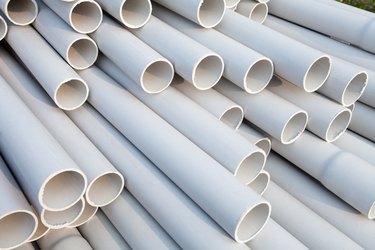
Polyvinyl chloride pipe, better known as PVC pipe, has been used in HVAC, plumbing, electrical, and even furniture making for decades. Heating PVC pipe excessively changes the pipe's ability to hold pressure and can produce hazardous fumes. While it is common for electricians to heat PVC conduit (pipe used for routing and protecting wiring) to create custom bends in the conduit, it is not at all common to apply high heat to PVC plumbing pipe, and this is not recommended for DIYers.
Dangers of Burning PVC
Video of the Day
The harmful effects of burning polyvinyl chloride pipe are largely unverified. What can be verified is that if PVC does actually catch on fire, the fumes coming off the pipe at 158 degrees Fahrenheit are hydrogen chloride gas burning off of the surface of the PVC. This gas will actually displace oxygen, causing the flames to nearly self-extinguish. This is not to say that it isn't harmful to anyone exposed to the fumes, but the PVC will not feed a fire easily.
Video of the Day
PVC and Temperatures
PVC pipe is a thermoplastic, which means its physical properties change with changes in temperature. PVC pipe pressure ratings reduce as the temperature of the liquid being carried increases. A pipe rated for 150 psi at 73 F will reduce to roughly 125 psi at 110 F. These numbers may vary based on the elasticity of the PVC. Inversely, as the temperatures decrease below 73 F, the pipe will get more stiff or brittle. Thus, both heating and cooling PVC pipe has an effect on the performance of the pipe.
PVC Pipe Melting Point
Heating PVC conduit to form a bend in the pipe is a standard part of many electrical installations. The problem with heating up the pipe is that there is a fine line in the temperatures between the PVC pipe's point of being pliable to form bends and PVC's melting point.
PVC melts at around 176 F. The fine line is that somewhere around 170 F is the temperature for making long radius bends in the pipe. Tighter bends can be made but will be at the melting temperature. There is not a lot of room for error. Professionals many times use either special heating blankets or actual PVC heaters for making bends with PVC and still melt the pipe fairly easily. Bending PVC takes a fair amount of practice to do successfully, even with the right tools.
Hazardous PVC Fumes
One of the downsides to using polyvinyl chloride is the toxicity of the fumes. The fumes emitted when the PVC is heated to 158 F or when in a fire can be hazardous to the health of those nearby. How much it takes to make you sick is unknown. Those in the manufacturing industry who use PVC in the making of the pipe are more at risk than those heating conduit for construction work.
Safety While Using PVC
Wearing the proper personal protective equipment is always the best safety measure when doing anything, and working with PVC is no different. No matter what you are doing, it can never hurt to look up the material you are dealing with and take a gander at the safety data sheet. There is limited information regarding the long-term effects of the fumes given off by PVC. But you can never go wrong being in a well-ventilated area, using a fan, and maybe even wearing a respirator while working with PVC.